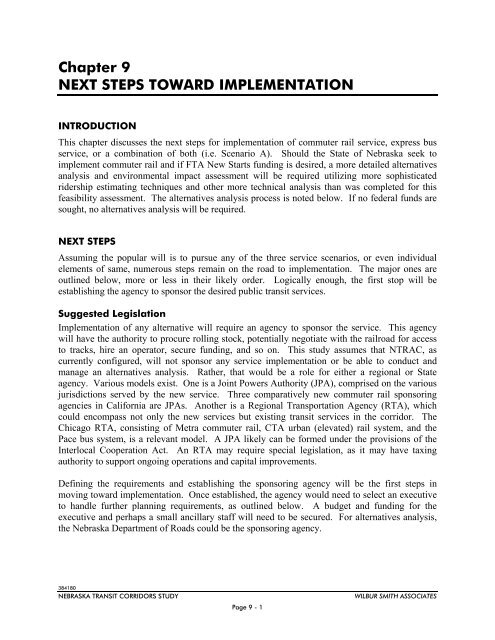NTRAC Final Study - Nebraska Department of Roads - State of ...
NTRAC Final Study - Nebraska Department of Roads - State of ...
NTRAC Final Study - Nebraska Department of Roads - State of ...
Create successful ePaper yourself
Turn your PDF publications into a flip-book with our unique Google optimized e-Paper software.
Chapter 9<br />
NEXT STEPS TOWARD IMPLEMENTATION<br />
INTRODUCTION<br />
This chapter discusses the next steps for implementation <strong>of</strong> commuter rail service, express bus<br />
service, or a combination <strong>of</strong> both (i.e. Scenario A). Should the <strong>State</strong> <strong>of</strong> <strong>Nebraska</strong> seek to<br />
implement commuter rail and if FTA New Starts funding is desired, a more detailed alternatives<br />
analysis and environmental impact assessment will be required utilizing more sophisticated<br />
ridership estimating techniques and other more technical analysis than was completed for this<br />
feasibility assessment. The alternatives analysis process is noted below. If no federal funds are<br />
sought, no alternatives analysis will be required.<br />
NEXT STEPS<br />
Assuming the popular will is to pursue any <strong>of</strong> the three service scenarios, or even individual<br />
elements <strong>of</strong> same, numerous steps remain on the road to implementation. The major ones are<br />
outlined below, more or less in their likely order. Logically enough, the first stop will be<br />
establishing the agency to sponsor the desired public transit services.<br />
Suggested Legislation<br />
Implementation <strong>of</strong> any alternative will require an agency to sponsor the service. This agency<br />
will have the authority to procure rolling stock, potentially negotiate with the railroad for access<br />
to tracks, hire an operator, secure funding, and so on. This study assumes that <strong>NTRAC</strong>, as<br />
currently configured, will not sponsor any service implementation or be able to conduct and<br />
manage an alternatives analysis. Rather, that would be a role for either a regional or <strong>State</strong><br />
agency. Various models exist. One is a Joint Powers Authority (JPA), comprised on the various<br />
jurisdictions served by the new service. Three comparatively new commuter rail sponsoring<br />
agencies in California are JPAs. Another is a Regional Transportation Agency (RTA), which<br />
could encompass not only the new services but existing transit services in the corridor. The<br />
Chicago RTA, consisting <strong>of</strong> Metra commuter rail, CTA urban (elevated) rail system, and the<br />
Pace bus system, is a relevant model. A JPA likely can be formed under the provisions <strong>of</strong> the<br />
Interlocal Cooperation Act. An RTA may require special legislation, as it may have taxing<br />
authority to support ongoing operations and capital improvements.<br />
Defining the requirements and establishing the sponsoring agency will be the first steps in<br />
moving toward implementation. Once established, the agency would need to select an executive<br />
to handle further planning requirements, as outlined below. A budget and funding for the<br />
executive and perhaps a small ancillary staff will need to be secured. For alternatives analysis,<br />
the <strong>Nebraska</strong> <strong>Department</strong> <strong>of</strong> <strong>Roads</strong> could be the sponsoring agency.<br />
384180<br />
NEBRASKA TRANSIT CORRIDORS STUDY<br />
Page 9 - 1<br />
WILBUR SMITH ASSOCIATES

















